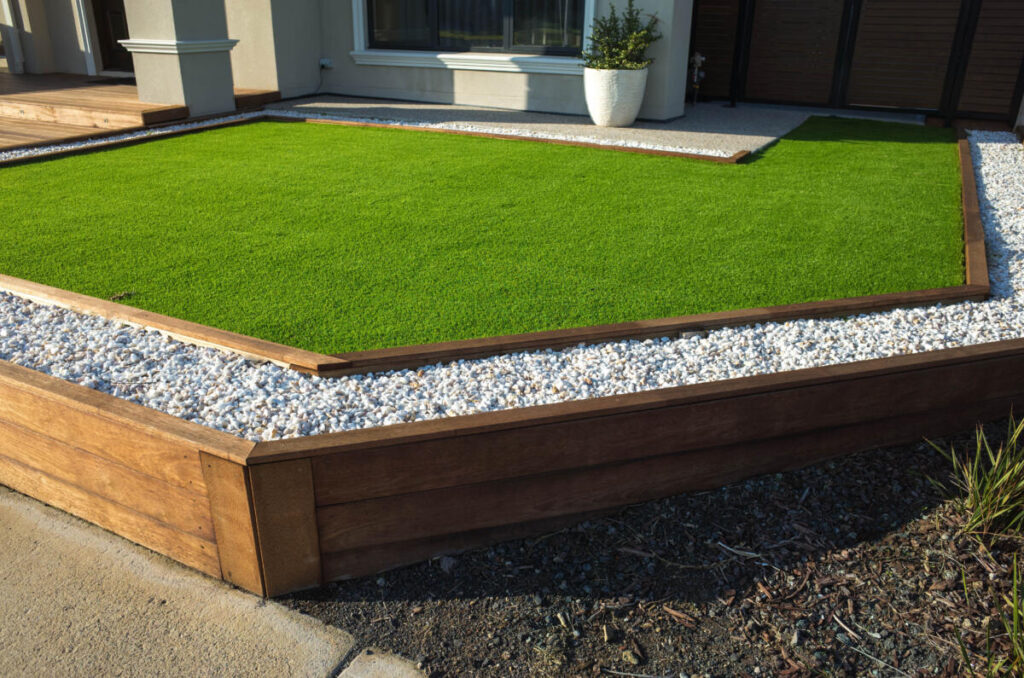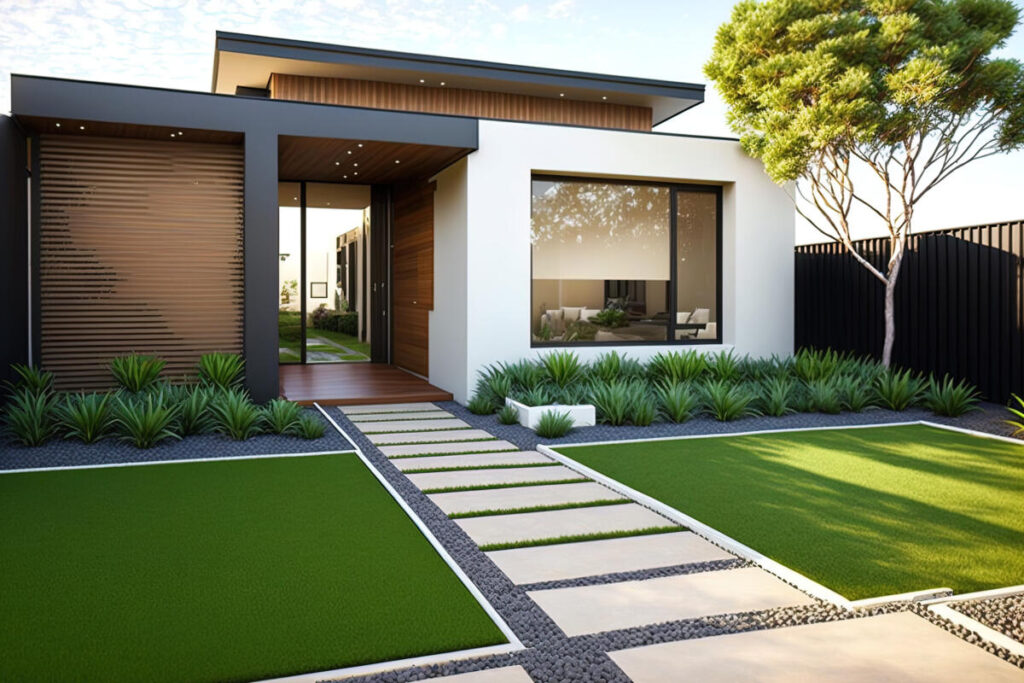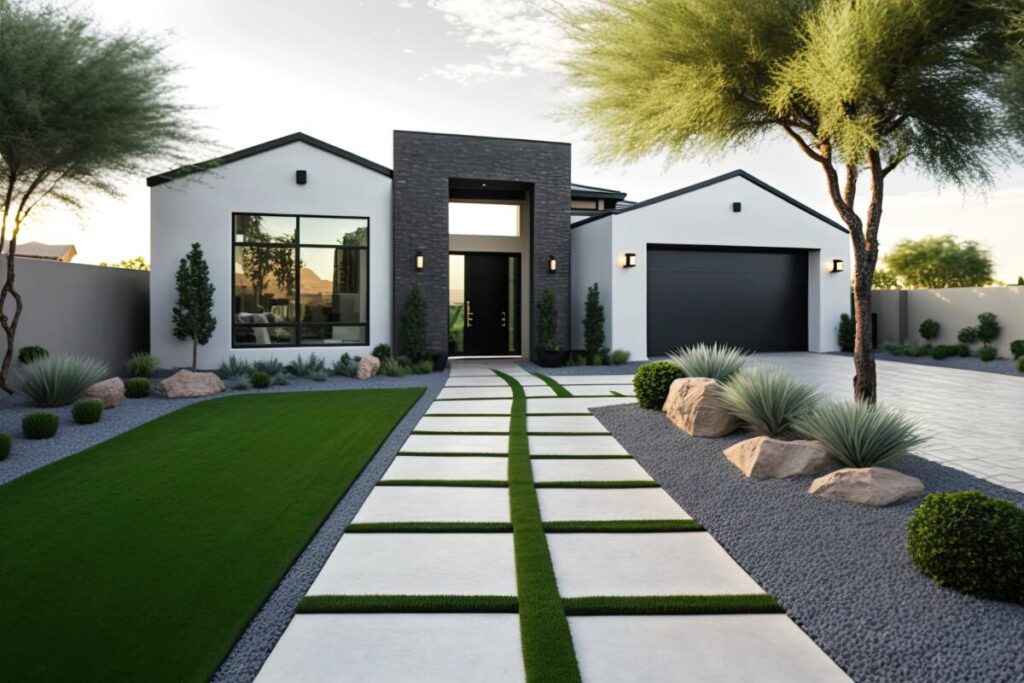Tired of spending hours maintaining your yard? Imagine a beautiful landscape that requires minimal effort and thrives in your local climate. Low-maintenance landscaping offers an alternative to traditional yard work, allowing you to enjoy your outdoor spaces without sacrificing your weekends. This blog post will guide you through nine low-maintenance landscaping ideas to transform your yard into an inviting, sustainable, and easy-to-care-for oasis.
Short Summary
- Design a beautiful, low-maintenance outdoor space with native plants and hardscaping elements.
- Utilize perennials for lasting beauty, container gardening for flexibility, water saving strategies to conserve resources.
- Enhance the landscape with garden art or opt for lawn free landscaping solutions such as artificial turf and gravel.
Designing for Low Maintenance
Creating low maintenance landscaping starts with the right design principles. By carefully selecting native plants, incorporating functional hardscaping elements, and planning an efficient layout, you can achieve a beautiful yard that requires minimal effort to maintain. In this process, considering yard landscaping ideas, low maintenance landscaping ideas, and low maintenance landscaping tips is essential for a successful outcome.
With these guiding principles, you’ll be on your way to enjoying a stunning, eco-friendly, and low-maintenance outdoor space.
Plant Selection: Opt for native plants, perennials, and low-maintenance varieties.
One of the most effective strategies for creating a low-maintenance landscape is to choose native plants, perennials, and low-maintenance varieties such as ornamental grasses for your garden beds. Native plants are well-adapted to your local climate and require less water and upkeep than non-native species. Perennials, such as Black-eyed Susans and Montauk daisies, provide vibrant color and return year after year, reducing the need for frequent replanting.
Additionally, low-maintenance plants like Echeveria, agave, and sedum thrive in sunny areas and require minimal care, making them perfect additions to your outdoor living space.
Hardscaping: Incorporate functional hardscaping elements like patios, walkways, and walls using durable materials.
Incorporating hardscaping elements such as patios, walkways, and walls can greatly reduce the maintenance requirements of your yard landscaping. By using durable materials like natural stone and concrete, you can create resilient surfaces that don’t require weeding or watering. Hardscaping offers a classic look that can last a lifetime, with the added benefit of reducing water runoff and providing more durability than timber walls.
As a result, your outdoor space will be both functional and low-maintenance, allowing you to spend more time enjoying your beautiful yard.
Layout: Plan for efficient use of space, grouping plants with similar needs together, and creating focal points.
Efficient use of space is crucial in low-maintenance landscaping. By grouping plants with similar needs together, you can simplify their care and maintenance. For example, organizing plants with similar water, light, and soil requirements can help ensure they receive the necessary care while also creating a more aesthetically pleasing landscape. Moreover, effective utilization of space allows for better circulation and functionality, ensuring that your landscape is both visually appealing and practical.
Creating focal points in your landscape adds visual appeal and attracts attention. This can be achieved through the use of plants with striking foliage or vibrant flowers, or by incorporating hardscaping elements such as water features, sculptures, or seating areas. By combining efficient use of space with visually appealing focal points, you’ll create a low-maintenance landscape that is both beautiful and easy to care for.

1. Ground Cover Alternatives
Traditional lawns can be time-consuming and resource-intensive to maintain. By exploring ground cover alternatives, you can reduce lawn maintenance and create a more sustainable landscape. Some options include mulch, crushed stone, and low-maintenance plants like New Zealand brass buttons, Scotch or Irish moss, and low-growing clover. These ground covers not only reduce the need for mowing and watering, but also add visual interest to your yard.
Another option for a low-maintenance yard is xeriscaping, a gardening method that involves selecting plants that require minimal supplemental watering. By incorporating drought-tolerant plants and efficient irrigation systems into your landscape design, you can conserve water and create a yard that requires less maintenance while still looking beautiful and lush.
2. Utilizing Native Plants
Incorporating native plants into your landscape design offers numerous benefits. These plants are well-suited to your local climate and soil conditions, making them more likely to thrive in your yard. Additionally, native plants require less water and fertilizer than non-native varieties, reducing maintenance requirements and contributing to a more sustainable landscape.
Some examples of suitable native plants for landscaping include Wild Aster, Orange Coneflower, Dense Blazing Star, and Virginia Bluebells. By utilizing these and other native plants in your landscape, you can create a low-maintenance garden that supports local wildlife and promotes biodiversity while still providing a visually stunning outdoor space.
3. Perennial Power
Perennials offer a low-maintenance alternative to annuals, as they return year after year and typically require less care than their annual counterparts. By incorporating a variety of perennials into your landscape, you can create beautiful, ever-changing views throughout the year. Some examples of perennials that are well-suited for landscaping include Asiatic Lily, Asters, Astilbe, Black-Eyed Susan, and Chrysanthemum. These vibrant plants bring color and charm to your garden with minimal upkeep, allowing you to enjoy a beautiful landscape with less effort.
4. Container Gardening
Container gardening offers a versatile and low-maintenance solution for adding color and texture to your outdoor spaces. By using containers, you can easily rearrange plants and experiment with different layouts and designs, creating a dynamic and ever-changing garden with minimal effort.
Some examples of plants that are well-suited for container gardening include vegetables such as potatoes, tomatoes, and green beans, as well as flowers like geraniums, hibiscus, and sweet potato vine. Additionally, by employing water-saving strategies such as self-watering containers or olla jars, you can create a more sustainable and low-maintenance container garden that still thrives and adds visual interest to your outdoor space.

5. Hardscape Solutions
Hardscape solutions offer an effective way to create functional and low-maintenance outdoor areas in your yard. By incorporating elements such as patios, walkways, and walls, you can minimize the need for upkeep while still creating inviting and usable spaces.
Some examples of hardscape solutions for landscaping include patios, decks, gazebos, outdoor kitchens, artificial grass, driveways, fire pits, pergolas, and stepping stones. By using these elements in your landscape design, you can create a beautiful and functional yard that requires minimal maintenance, allowing you to spend more time enjoying your outdoor spaces.
6. Water-Saving Strategies
Adopting water-saving strategies is essential for creating a sustainable and low-maintenance landscape. By implementing rain barrels, drought-tolerant plants, and efficient irrigation systems, you can conserve water while still maintaining a lush and attractive garden.
Rain barrels collect and store rainwater, providing a valuable resource for watering your plants during dry periods. Drought-tolerant plants, such as succulents, cacti, and native species, require minimal water to thrive, making them an ideal choice for low-maintenance gardens.
Efficient irrigation systems, like drip irrigation and soaker hoses, deliver water directly to your plants’ roots, reducing water waste and ensuring that your garden receives the moisture it needs without excessive watering. A garden hose can also be a helpful tool for targeted watering when used mindfully.
7. Outdoor Living Spaces
Creating inviting outdoor living spaces is a great way to enhance the functionality and beauty of your yard. By using low-maintenance materials and design elements, you can create spaces that are both functional and visually appealing. Some elements you can incorporate into your outdoor living spaces include levels, distinctive lighting, a pergola, a fireplace or fire pit, an outdoor kitchen, and comfortable seating areas.
Adding potted plants to your outdoor living spaces can also add color and texture, while their portability allows for easy rearrangement and versatility in your design. By creating inviting outdoor living spaces, you can transform your yard into a functional, low-maintenance oasis that you and your family will enjoy for years to come.
8. Enhancing with Garden Art
Adding garden art to your landscape can provide a personalized touch and create visual interest in your yard. Sculptures, birdbaths, and decorative accents can be used to enhance the overall aesthetic of your outdoor spaces and provide a unique focal point.
Garden art can be constructed from a range of materials, such as wood, metal, stone, and even recycled or cost-effective materials. When selecting and placing garden art, consider the visibility and appreciation of the piece, placing it near pathways, seating areas, or other focal points in the landscape.
By incorporating garden art into your landscape design, you can create a one-of-a-kind outdoor space that reflects your personality and style, while also enhancing the beauty of your garden bed.

9. Lawn-Free Landscaping
Lawn-free landscaping offers an alternative to traditional lawn space, reducing maintenance requirements while still creating an attractive and functional yard. Some options for lawn-free landscaping include artificial turf, gravel, and ground covers like low-growing clover or New Zealand brass buttons.
Artificial turf installation offers a particularly low-maintenance option, with a lifespan of up to 20 years and no need for mowing, watering, fertilizing, or weeding. By considering lawn-free landscaping options, you can create a beautiful and functional yard that requires minimal maintenance and allows you to spend more time enjoying your outdoor spaces.
Getting the Best Results from Low-Maintenance Landscaping
Low-maintenance landscaping offers a variety of benefits, including reduced yard work, a more sustainable yard/garden, and increased enjoyment of your outdoor spaces. By incorporating native plants, perennials, and low-maintenance plants, embracing hardscape solutions, and exploring lawn-free landscaping options, you can create a beautiful, functional, and eco-friendly yard. With these nine low-maintenance landscaping ideas, you can transform your outdoor spaces into an inviting oasis that requires minimal effort to maintain and provides endless enjoyment.
If your looking for a trusted team of landscaping professionals to trust with either converting your yard into a stunning low maintenance landscape, or even just taking care of the yard maintenance, Three Timbers is here to help. Contact us today to learn more!
Frequently Asked Questions
What is the best low-maintenance landscaping material?
For the best low-maintenance landscaping material, consider using lawn alternatives like mixed shrubs or perennials, natural areas, ground covers, mulch, artificial turf, paving stones, and succulents. Such materials require less watering, weeding, and maintenance while still providing vibrant pops of green and a durable surface.
What are some low-maintenance ground cover alternatives to traditional lawns?
New Zealand brass buttons, Scotch or Irish moss, and low-growing clover are all great options for a hassle-free alternative to the traditional lawn. These plants are easy to maintain, require little water, and can be used to create a unique and attractive landscape. They are also more environmentally friendly than a traditional lawn, as they require less fertilizer and pesticides.
How can garden art enhance the landscape?
Garden art can enhance the landscape by adding visual interest and personalization through sculptures, birdbaths, and decorative accents. These pieces can be used to create a unique look that reflects the homeowner’s style and taste. They can also be used to add a touch of whimsy and charm to an otherwise dull landscape.
What are some water-saving strategies for a sustainable landscape?
Implementing rain barrels, drought-tolerant plants, and efficient irrigation systems are key water-saving strategies for a sustainable landscape. These strategies can help reduce water consumption and save money on water bills. They also help conserve water resources and protect the environment. Rain barrels are a great way to capture and store rainwater for later use. D. D.


